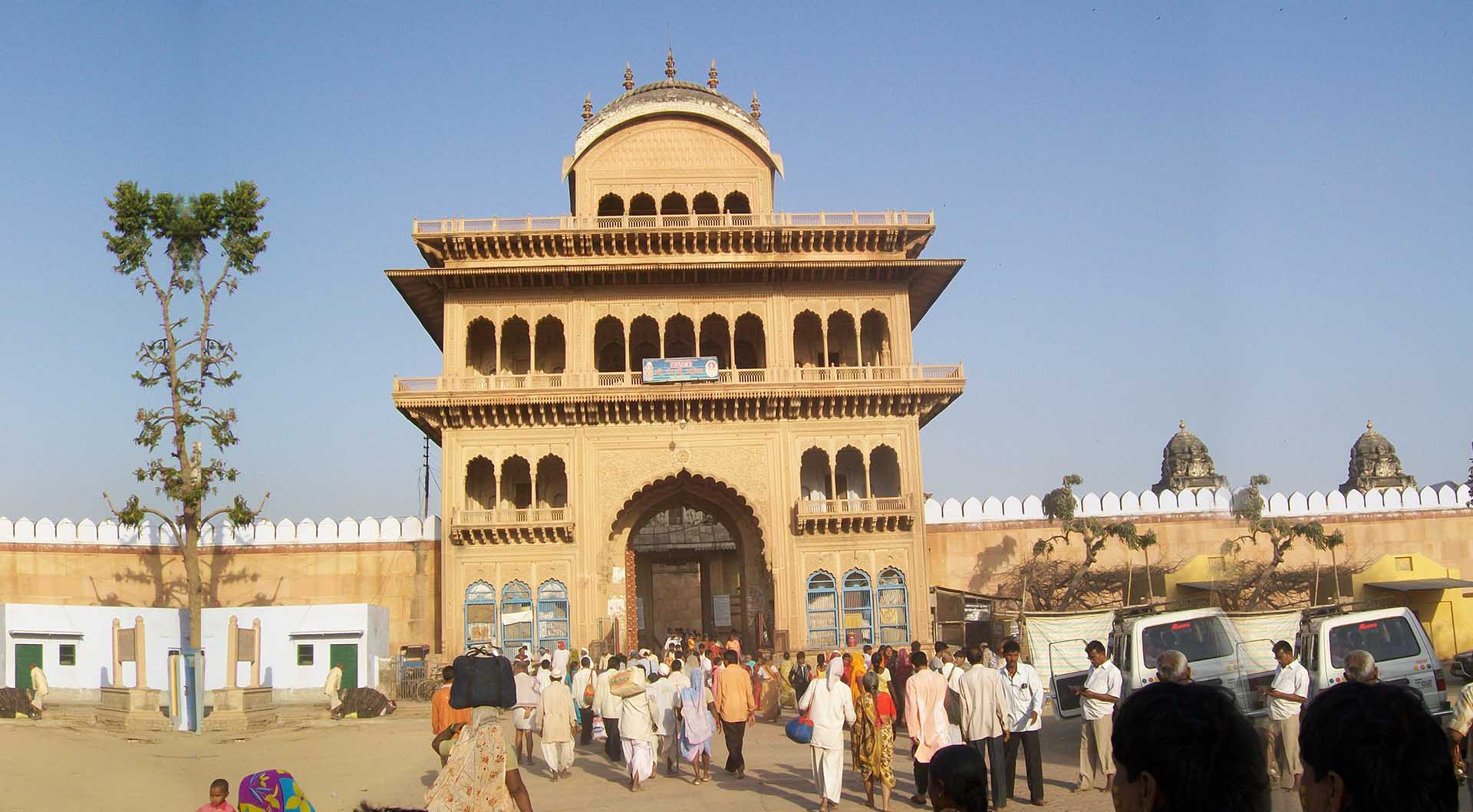
Rangji Mandir
The Rangji temple, founded by Seths Gobind Das and Radha Krishan, brothers of the famous millionaire Lakhmi Chand, is dedicated to Rang Ji, or Sri Ranga Nath, that being the special name of Vishnu most affected by Ramanuja, the founder of the Sri Sampradaya. It is built in the Madras style, in accordance with plans supplied by their guru, the great Sanskrit scholar, Swami Rangacharya, a native of that part of India.
The works were commenced in 1845 and completed in 1851, at a cost of 45 lakhs of rupees. The outer walls measure 773 feet in length by 440 in breadth, and enclose a fine tank and garden in addition to the actual temple-court. This latter has lofty gate-towers, or gopuras, covered with a profusion of coarse sculpture. In front of the god is erected a pillar, or dhvaja stambha, of copper gilt, sixty feet in height, and also sunk some twenty-four feet more below the surface of the ground. This alone cost Rs. 10,000. The principal or western entrance of the outer court is surmounted by a pavilion, ninety-three feet high, constructed in the Mathura style after the design of a native artist. In its graceful outlines and the elegance of its reticulated tracery, it presents a striking contrast to the heavy and misshapen masses of the Madras Gopura, which rises immediately in front of it. A little to one side of the entrance is a detached shed, in which the god's rath, or carriage, is kept. It is an enormous wooden tower in several stages, with monstrous effigies at the corners, and is brought out only once a year in the month of Chait during the festival of the Brahmotsav. The mela lasts for ten days, on each of which the god is taken in state from the temple along the road, a distance of 690 yards, to a garden where a pavilion has been erected for his reception. The procession is always attended with torches, music, and incense, and some military display contributed by the Raja of Bharatpur. On the day when the rath is used, the image, composed of the eight metals, is seated in the centre of the car, with attendant Brahmans standing on either side to fan it with chauris.
Rath Yatra, Rang Ji Temple,Vrindavan, Mathura
Each of the Seths, with the rest of the throng, gives an occasional hand to the ropes by which the ponderous machine is drawn; and by dint of much exertion, the distance is ordinarily accomplished in the space of about two and-a-half hours. On the evening of the following day there is a grand display of fire-works, to which all the European residents of the station are invited, and which attracts a large crowd of natives from the country round about. On other days when the rath is not brought out, the god has a wide choice of vehicles, being borne now on a palki, a richly gilt 'tabernacle' (punya-kothi), a throne (sinhasan), or a tree, either the kadamb, or the tree of Paradise (kalpa-vriksha); now on some demi-god, as the sun or the moon, Garura, Hanuman, or Sesha; now again on some animal, as a horse, an elephant, a lion, a swan, or the fabulous eight-footed Sarabha. The ordinary cost of one of these celebrations is about Rs. 5,000, while the annual expenses of the whole establishment amount to no less than Rs. 57,000, the largest item in that total being Rs. 30,000 for the bhog or food, which after being presented to the god is then consumed by the priests or given away in charity. Every day 500 of the Sri Vaishnava sect are fed at the temple, and every morning up to ten o'clock a dole of flour is given to anyone of any denomination who chooses to apply for it.
Schedule:
Morning 5 : 00 - 11 : 00 5 : 00 - 12 : 00Evening 4 : 00 - 8 : 00 3 : 00 - 7 : 00
Aarti Morning 5 : 30 - 6 : 00 6 : 00 - 6 : 30
Aarti Evening 6 : 30 - 7 : 00 6 : 00 - 6 : 30


